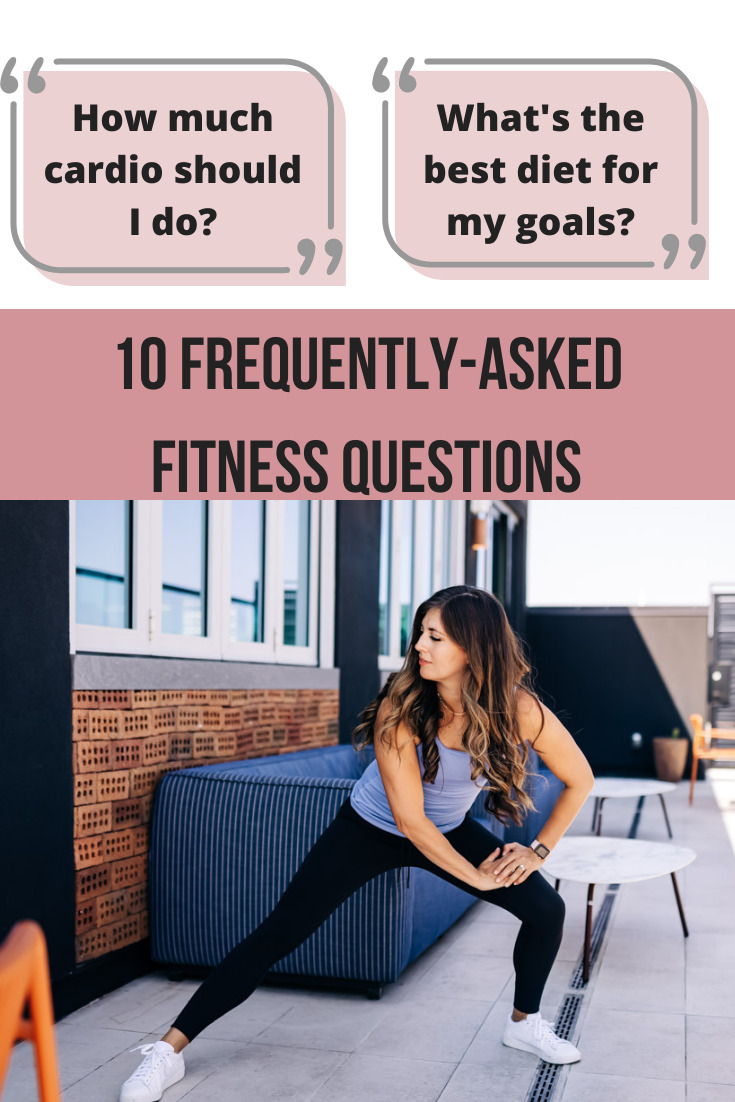
Do you have a question about fitness? Sharing a post with some of the questions I commonly receive about fitness with their answers. Please keep in mind that while I’m a certified personal trainer, women’s fitness specialist, Integrative Health Practitioner, and P1 Nutrition Coach, I’m not a doctor or Registered Dietitian. If you have specific health considerations, please reach out to a local health professional for guidance.
Hi friends! Hope you’re having a wonderful day. For today’s post, I wanted to re-share this updated post with some frequently-asked fitness questions and their answers. These are the types of questions I receive from clients all of the time, and many of these questions I also had myself when I was first getting started in the fitness world.
If you have any burning fitness questions, please leave them in the comments below!
10 frequently-asked fitness questions and their answers
1. How much cardio should I be doing?
The answer to many of the questions on this list, including this one, is “it depends.” I know. It’s frustrating to hear that answer, but I’ll break down WHY and hopefully this will help you determine the best method for your unique body.
With cardio, the amount you’re doing depends on a lot of different factors: your current activity level, your goals, and how hard you’re working. If you’re currently sedentary, general recommendations of around 150 minutes of moderate cardio each week (about 30 minutes most days of the day), would be way too much. In that case, you’d start with shorter rounds: 10-15 minutes each day of easy cardio (like walking) and build on from there.
If your goal is strength and lean muscle gains, you don’t want to do too much cardio. No daily long jogs if you want to build muscle, because after a certain point, your body will begin to use protein (aka muscle) as fuel. Many strength training exercises, especially circuit training, can count as cardio if it elevates your heart rate and sustains it. Circuit training also burns more calories during the workout. Many workouts can hit the strength and cardio box in one session and remember that intensity and purpose > duration.
If you are consistently doing high intensity cardio workouts (like HIIT or sprints), you will need less overall cardio time because you’re working harder. Check out this post on how much cardio you should be doing, and how to modify it for your intensity and fitness level.
2. How often should I rest?
Rest is such a huge piece of the fitness puzzle and it’s easy to forget that the magic happens when we REST. This is when the body is able to restore its levels, rebuild muscle, and gather energy and fuel for the next session. If you’re constantly working yourself into the ground, there’s a point where you’ll hit diminishing returns. Too much exercise can lead to overtraining, which can potentially cause elevated resting heart rate, injury, poor sleep, low energy levels, depression/anxiety, agitation, decrease in performance, and extreme soreness/pain.
The amount of rest you need will also depend on your current routine, how quickly you recover, your fueling strategies, and the intensity of your workouts. If you’re working out at intense levels a few times each week, you may need more rest time to recover in between sessions. If your workouts are lower-intensity, you could possibly work out every day without the effects of overtraining. Make sure you have at least 1-2 days of full rest each week to allow the body to repair and prevent overtraining.
3. Should I stretch before my workouts?
Research is mixed on this, so if you don’t want to stretch, you can skip it! Static stretching before a workout has actually been shown to DECREASE speed and performance. If you’re going to stretch before a workout, use this chance to move your body through full range of motion exercises to prepare for the workout you’re about to do. Your warmup moves should mimic the “meat” of your workout and include dynamic stretching. Static stretching (holding for 15-25 seconds per stretch) is a better choice AFTER your workout. You can foam roll either before or after your workout.
4. How much weight should I be lifting when I strength train?
When you choose a weight for strength training, pick a weight that’s “heavy for you.” For example, 5 lbs may be heavy for one person, while 50 lbs is heavy for someone else. This will depend on your current strength and fitness level.
You should be able to complete all reps in a set with good form, and have to push yourself to finish the last 1-2 reps of each set. If you could easily breeze through 15-20 reps of an exercise at your current weight, it’s a good sign to bump it up a little. On the other hand, if you’re struggling to complete all reps and compromising form, decrease the amount of weight or resistance you’re using.
5. How To Lose Weight And Tone Up Fast?
When I get this question, friends are often referring to building muscle to get that “toned” and defined look, and possibly losing a bit of body fat so the muscle is revealed. You can absolutely burn fat and build muscle at the same time, but it takes conscious nutrition and training. You’ll ideally want to be in a little bit of a calorie deficit, weight training with challenging weights, and eating sufficient protein. (I typically recommend 1g of protein per pound of goal body weight, depending on goals and preferred eating style. For example, I’ll recommend less protein for a vegan friend.)
Nutrient timing can also play a part in this, once nutrition foundations are set (protein and produce throughout the day, adequate hydration, eating slowly and mindfully, eating to your needs).
To lose body fat, consume a majority of carb-dense foods before and after exercise. Outside of the 3-hour window following exercise, you can shift your focus to mostly protein, veggies, and healthy fats (25% of each following meal using carb-dense foods).
Here is a handy infographic with some nutrition guidelines, based on body type:
For your workouts, add in new stressors (like a barbell instead of dumbbells, unilateral exercises, heavier resistance, band loops) and follow a plan based on periodization strategies. You need a plan? I gotchu, boo.
6. What should I do about muscle soreness?
Contrary to common belief, sore muscles do not mean that you had a *good workout* and you shouldn’t aim to be seriously sore after each session. I find that when clients are super sore, it hinders their activity level for the rest of the day and days following the workout. For this reason, we take it easy on the first session because no matter what we do, it’s different and new, which means they’ll be a tiny bit sore.
What’s the benefit of pushing yourself super hard so you can’t move the rest of the week? If your muscles are incredbily sore, focus on adequate water and protein intake, stretch your muscles (dynamic and static stretching feels great), a bath with epsom salts, and magnesium oil. Easy cardio and moving the legs can help to reduce soreness. Also, if you have a sauna blanket or access to a sauna, this is an incredible recovery tool for sore muscles and inflammation. Make sure you’re designating 1-2 days as a recovery day during the week, too.
7. How do I get started?
As always, talk with a doctor before making any fitness changes. The best way to start a fitness program is consistent walking and establishing a cardio baseline. Aim for 5-15 minutes most days of the week. Once you’re able to hit this consistently for a few weeks, add in 5 minutes until you can reach the 150 minutes of moderate cardio guidelines. (30 minutes, 5 days per week) From here, I recommend meeting with a certified personal trainer to determine a personalized strength plan you can follow 1-2 days per week. (One upper, one lower, or two total body circuits) From here, you’ll be able to progress into different strength training styles and methods depending on your goals, but I love starting with walking!
8. What’s the best diet for my fitness goals?
This depends on so many things: medical history, preferred eating style, activity level, metabolism, medications, specific goals (do you want to lose weight? Build muscle? Maintain?), how many meals you like to eat each day, so.many.things. This is why one-size-fits-all nutrition programs are a huge red flag. I recommend focusing on the foundations first: eating enough vegetables and leafy greens, protein intake, hydration, eating slowly and mindfully, and eating to your needs. If you need help with nutrition foundations, you can apply for 1:1 coaching. Make sure you’re on my newsletter here so you get details on new programs first!
9. How often should I work out?
This depends on intensity and your goals. If your goal is general movement, your ideal amount of workout days will be different than someone who is training for a grueling athletic event. You could train 2-7 times per week, depending on intensity. Make sure to vary intensity in your workout plan each week so you have a mix of challenging, easy, and moderate intensity levels. Always include 1-2 days of full rest. Need help creating a workout plan? Here’s a post I did allllll about this.
10. Should I work out my abs every day?
Nope! Back in the day, I thought if you wanted a six-pack you needed to work out your abs every day. Our abdominals are like any other muscle group: they need rest to recover and repair. Also, SO many exercises that are not considered “ab exercises” work your core, like squats, deadlifts, push-ups, hip raises, balance work, etc. If you put your mind to muscle and focus on breathing during your exercises, you may be surprised to see how much this works your core and can improve definition and strength. I don’t think you need to do core work more than 2-3 times max per week.
Whew! High fives to all of my friends out there who made it through this entire post. 🙂 It was a beefy one, but I love talking about this stuff and answering your questions.
Do you have any burning fitness questions?
What are some of your tips for friends out there who are just getting started?
xo
Gina
The post 10 frequently-asked fitness questions and their answers appeared first on The Fitnessista.




.jpg)



0 comments: